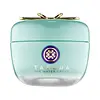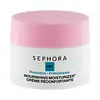What's inside
What's inside
 Key Ingredients
Key Ingredients

 Benefits
Benefits

 Concerns
Concerns

 Ingredients Side-by-side
Ingredients Side-by-side

Water
Skin ConditioningSaccharomyces/Rice Ferment Filtrate
Skin ConditioningDimethicone
EmollientPropanediol
SolventGlycerin
HumectantDiglycerin
HumectantDiphenylsiloxy Phenyl Trimethicone
Skin ConditioningCamellia Sinensis Leaf Extract
AntimicrobialCladosiphon Okamuranus Extract
Skin ConditioningPEG-9 Polydimethylsiloxyethyl Dimethicone
EmulsifyingGold
Cosmetic ColorantBelamcanda Chinensis Root Extract
Skin ConditioningRosa Multiflora Fruit Extract
MaskingHouttuynia Cordata Extract
Skin ConditioningSophora Angustifolia Root Extract
Skin ConditioningSodium Hyaluronate
HumectantLecithin
EmollientPistacia Lentiscus Gum
MaskingSodium Chloride
MaskingSodium Citrate
BufferingMica
Cosmetic ColorantTin Oxide
AbrasiveDimethicone/PEG-10/15 Crosspolymer
Dimethicone/Phenyl Vinyl Dimethicone Crosspolymer
Tocopherol
AntioxidantButylene Glycol
HumectantEthylhexylglycerin
Skin ConditioningDipropylene Glycol
HumectantParfum
MaskingAlcohol
AntimicrobialPhenoxyethanol
PreservativeLimonene
PerfumingLinalool
PerfumingCitral
PerfumingCI 77891
Cosmetic ColorantWater, Saccharomyces/Rice Ferment Filtrate, Dimethicone, Propanediol, Glycerin, Diglycerin, Diphenylsiloxy Phenyl Trimethicone, Camellia Sinensis Leaf Extract, Cladosiphon Okamuranus Extract, PEG-9 Polydimethylsiloxyethyl Dimethicone, Gold, Belamcanda Chinensis Root Extract, Rosa Multiflora Fruit Extract, Houttuynia Cordata Extract, Sophora Angustifolia Root Extract, Sodium Hyaluronate, Lecithin, Pistacia Lentiscus Gum, Sodium Chloride, Sodium Citrate, Mica, Tin Oxide, Dimethicone/PEG-10/15 Crosspolymer, Dimethicone/Phenyl Vinyl Dimethicone Crosspolymer, Tocopherol, Butylene Glycol, Ethylhexylglycerin, Dipropylene Glycol, Parfum, Alcohol, Phenoxyethanol, Limonene, Linalool, Citral, CI 77891
Water
Skin ConditioningGlycerin
HumectantCoco-Caprylate/Caprate
EmollientIsostearyl Isostearate
EmollientIsononyl Isononanoate
EmollientC10-18 Triglycerides
EmollientGlyceryl Oleate Citrate
EmulsifyingInulin
Skin ConditioningHydroxypropyl Starch Phosphate
Stearyl Heptanoate
EmollientCetearyl Glucoside
EmulsifyingGlyceryl Stearate
EmollientSorbitan Olivate
EmulsifyingStearyl Caprylate
EmollientHydroxyethyl Acrylate/Sodium Acryloyldimethyl Taurate Copolymer
Emulsion StabilisingButylene Glycol
HumectantPersea Gratissima Oil
Skin ConditioningSclerocarya Birrea Seed Oil
HumectantCetearyl Alcohol
EmollientSqualane
EmollientHydroxyacetophenone
AntioxidantCanola Oil
EmollientGellan Gum
Tocopherol
AntioxidantSodium Polyacrylate
AbsorbentCarbomer
Emulsion Stabilising1,2-Hexanediol
Skin ConditioningCaprylyl Glycol
EmollientHelianthus Annuus Seed Oil
EmollientO-Cymen-5-Ol
AntimicrobialSodium Hydroxide
BufferingPolysorbate 60
EmulsifyingSorbitan Isostearate
EmulsifyingSodium Chloride
MaskingCitric Acid
BufferingWater, Glycerin, Coco-Caprylate/Caprate, Isostearyl Isostearate, Isononyl Isononanoate, C10-18 Triglycerides, Glyceryl Oleate Citrate, Inulin, Hydroxypropyl Starch Phosphate, Stearyl Heptanoate, Cetearyl Glucoside, Glyceryl Stearate, Sorbitan Olivate, Stearyl Caprylate, Hydroxyethyl Acrylate/Sodium Acryloyldimethyl Taurate Copolymer, Butylene Glycol, Persea Gratissima Oil, Sclerocarya Birrea Seed Oil, Cetearyl Alcohol, Squalane, Hydroxyacetophenone, Canola Oil, Gellan Gum, Tocopherol, Sodium Polyacrylate, Carbomer, 1,2-Hexanediol, Caprylyl Glycol, Helianthus Annuus Seed Oil, O-Cymen-5-Ol, Sodium Hydroxide, Polysorbate 60, Sorbitan Isostearate, Sodium Chloride, Citric Acid
 Reviews
Reviews

Ingredients Explained
These ingredients are found in both products.
Ingredients higher up in an ingredient list are typically present in a larger amount.
Butylene Glycol (or BG) is used within cosmetic products for a few different reasons:
Overall, Butylene Glycol is a safe and well-rounded ingredient that works well with other ingredients.
Though this ingredient works well with most skin types, some people with sensitive skin may experience a reaction such as allergic rashes, closed comedones, or itchiness.
Learn more about Butylene GlycolGlycerin is already naturally found in your skin. It helps moisturize and protect your skin.
A study from 2016 found glycerin to be more effective as a humectant than AHAs and hyaluronic acid.
As a humectant, it helps the skin stay hydrated by pulling moisture to your skin. The low molecular weight of glycerin allows it to pull moisture into the deeper layers of your skin.
Hydrated skin improves your skin barrier; Your skin barrier helps protect against irritants and bacteria.
Glycerin has also been found to have antimicrobial and antiviral properties. Due to these properties, glycerin is often used in wound and burn treatments.
In cosmetics, glycerin is usually derived from plants such as soybean or palm. However, it can also be sourced from animals, such as tallow or animal fat.
This ingredient is organic, colorless, odorless, and non-toxic.
Glycerin is the name for this ingredient in American English. British English uses Glycerol/Glycerine.
Learn more about GlycerinChances are, you eat sodium chloride every day. Sodium Chloride is also known as table salt.
This ingredient has many purposes in skincare: thickener, emulsifier, and exfoliator.
You'll most likely find this ingredient in cleansers where it is used to create a gel-like texture. As an emulsifier, it also prevents ingredients from separating.
There is much debate on whether this ingredient is comedogenic. The short answer - comedogenic ratings don't tell the whole story. Learn more about comegodenic ratings here.
The concensus about this ingredient causing acne seems to be divided. Research is needed to understand if this ingredient does cause acne.
Scrubs may use salt as the primary exfoliating ingredient.
Learn more about Sodium ChlorideTocopherol (also known as Vitamin E) is a common antioxidant used to help protect the skin from free-radicals and strengthen the skin barrier. It's also fat soluble - this means our skin is great at absorbing it.
Vitamin E also helps keep your natural skin lipids healthy. Your lipid skin barrier naturally consists of lipids, ceramides, and fatty acids. Vitamin E offers extra protection for your skin’s lipid barrier, keeping your skin healthy and nourished.
Another benefit is a bit of UV protection. Vitamin E helps reduce the damage caused by UVB rays. (It should not replace your sunscreen). Combining it with Vitamin C can decrease sunburned cells and hyperpigmentation after UV exposure.
You might have noticed Vitamin E + C often paired together. This is because it is great at stabilizing Vitamin C. Using the two together helps increase the effectiveness of both ingredients.
There are often claims that Vitamin E can reduce/prevent scarring, but these claims haven't been confirmed by scientific research.
Learn more about TocopherolWater. It's the most common cosmetic ingredient of all. You'll usually see it at the top of ingredient lists, meaning that it makes up the largest part of the product.
So why is it so popular? Water most often acts as a solvent - this means that it helps dissolve other ingredients into the formulation.
You'll also recognize water as that liquid we all need to stay alive. If you see this, drink a glass of water. Stay hydrated!
Learn more about Water